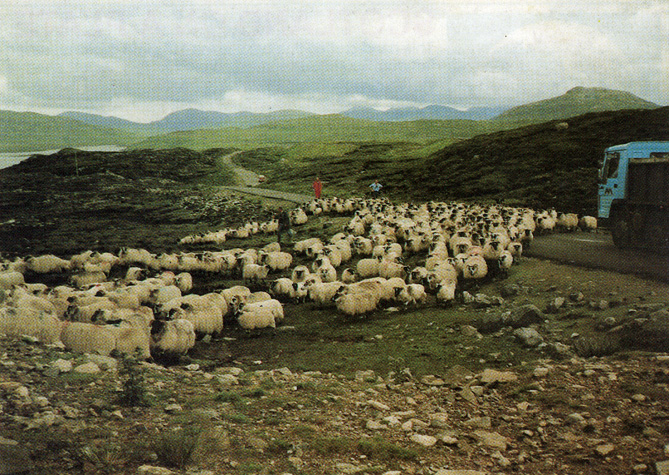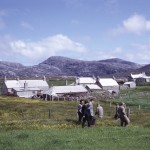Category: Life in Uig (page 3)
The Uig POs and their Postmarks
An Incident at Erista
19th Century Food
The Postman Retires
April
Side Schools in Uig II: Morsgail, Scaliscro and Linshader
Enterprise of Four Uigeachs
Crofting at the Upper End, 1958-9
Breanish and Islivig in 1959
February
Mussels and Peats
A Treat for a Cold Friday: Uig, 1964-65
The Gathering

This account of the gathering of the sheep into the Gisla fank for the clipping was written by David Henderson and first published in the Scots Magazine in August 1995. These large-scale community gatherings are now, sadly, a thing of the past. There are more pictures in the gallery, and of the fank at Loch Suainebhat here.
In the diffuse crofting culture of the Western Isles, the summer gathering of the sheep from the moors is one of the main highlights of community life. The practice has remained virtually unchanged since the arrival of the sheep in Lewis, and is a ritual I, as an incomer on holiday from Musselburgh, was priviledged to take part in. The gathering made the highlight of my stay.
My uncle Jim and I woke at dawn. The weather looked poor – drizzle and mist hid the view of Loch Roag from the kitchen window. I was sure the gathering would be put off – wet weather meant damp fleeces, difficult clipping and hours of drying for the Blackface wool we were to harvest.
Donald Calum Morrison, our crofting friend from Valtos, arrived at 7am as planned, refusing tea and looking skyward. “It looks awfully dull,” he said, “but no one’s phoned me so the gathering’s still on.”
Soon I was huddled in the back of Donald Calum’s austere van, sharing floorspace with an excited sheepdog who seemed to know what was in store. We rattled and bounced down the single track road, through Miavaig and on to the road south, pulling into passing places from time to time for a competing car, Donald Calum waving to them with the easy grace of one used to the island etiquette. Then we reached Gisla for the start of the walk into Morsgail Forest, a barren moor between Lewis and Harris where the Valtos crofters’ sheep roam their common grazings.
More than a dozen cars were gathered there. A brief discussion took place in the rain. All the crofters were annoyed that the weather had closed in – during the fortnight before, it had been “just like the Sahara,” as one local put it. There were pensive faces, shaking heads, pursed ips and whistling through teeth. “If it doesn’t dry up soon, the wool will be soaked,” said one man.
Gisla Fanks, 1990-1995
Summer Outings
The Lewis-Harris Boundary Dispute I: 1805
The Macdonald Triplets
Blackhouse Model for Green Homes

An article by Mary Beith, first published in the Scotsman in July 1990. Thanks to Mary for the opportunity to republish it.
A group of architects and others at Manchester University who had been devoting a great deal of time and thought to devising the environmentally ideal house of the future were understandably well pleased with the outcome of their researches.
That home would be long, narrow and rectangular, easy to span – thus cutting down on timber – highly insulated and with minimal windows; it would be a single volume house, not a series of separate rooms to ceiling level but divided by two-metre high partitions where the air could circulate freely above; and there would be a centralised heating source.
When one of the group contacted Bruce Walker, a lecture in architecture at the Duncan of Jordanston College and Dundee University, now on secondment to Historic Buildings and Monuments, the latter listened with not a little quiet amusement to the list of specifications for the ultimate in green homes.
“What you have just described,” he told his informant, “is a Western Isles black house – without the peat smoke.”
They have tremendous advantages, says Dr Walker: “Especially in that they were so much easier to heat with 100 per cent energy efficiency from the central fire which could generate the equivalent of 7 kilowatts. Later island houses had gable hearths with only 18 to 20 per cent efficiency with the bulk of the heat going out the chimney and even a modern stove is only 65 per cent efficient.”
Careful experiments with plastic models, incense and lightbulbs have proved not only the energy conservation qualities of the blackhouses but also the ingenious methods of their builders. That very peat smoke had its uses and there were ways of avoiding its disadvantages. The uneven-looking roofs and somewhat ill-fitting doors were not, Dr Walker had found, the results of haphazard and shoddy workmanship but a clever way of setting up convection currents caused by the heat given off by the cattle in the integral byre.


